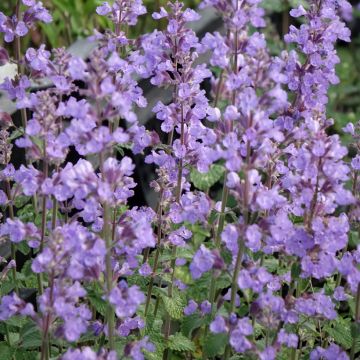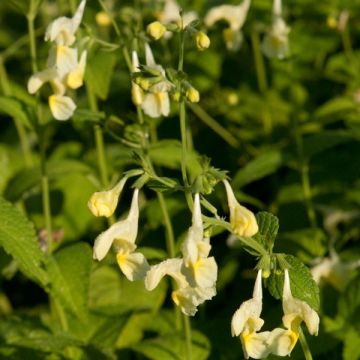

Nepeta nuda Annes Choice - Catnip
Nepeta nuda Annes Choice - Catnip
Nepeta nuda Anne's Choice
Naked Catnip, Naked Catmint
Plant received quickly and correctly packaged. Unfortunately, it did not withstand the heat.
Jacqueline, 14/09/2020
Special offer!
Receive a €20 voucher for any order over €90 (excluding delivery costs, credit notes, and plastic-free options)!
1- Add your favorite plants to your cart.
2- Once you have reached €90, confirm your order (you can even choose the delivery date!).
3- As soon as your order is shipped, you will receive an email containing your voucher code, valid for 3 months (90 days).
Your voucher is unique and can only be used once, for any order with a minimum value of €20, excluding delivery costs.
Can be combined with other current offers, non-divisible and non-refundable.
Home or relay delivery (depending on size and destination)
Schedule delivery date,
and select date in basket
This plant carries a 12 months recovery warranty
More information
We guarantee the quality of our plants for a full growing cycle, and will replace at our expense any plant that fails to recover under normal climatic and planting conditions.
Would this plant suit my garden?
Set up your Plantfit profile →
Description
This Nepeta nuda 'Anne's Choice' is a truly charming variety of Catmint or Catnip, full of refinement and lightness. It is perfectly at home in a rural setting, a natural garden, or in an English-style border. It is a tall, bushy, and dense perennial plant, with dark flower stems that bear a multitude of small pastel lavender flowers throughout the summer. Easy to grow in well-drained soil, with low water requirements, this plant brings lightness to low or non-irrigated borders. It pairs beautifully with rockery stones and allows for beautiful flowering pots.
Nepeta nuda, a plant that cats adore, is a perennial belonging to the Lamiaceae family. It is native to central and eastern Europe, as well as western Asia. In the wild this catmint grows on clayey-chalky soils that are poor in organic matter and rather dry in summer.
The 'Anne's Choice' variety has been selected for its vigour and floriferousness. It is a ramified herbaceous perennial with a bushy habit, forming a tuft 1.20 m (4ft) in height when in flower and occupying 70-80 cm (28-32in) of space on the ground. The foliage is deciduous, it disappears in winter and reappears in spring. In spring a cluster of sturdy, branched stems emerges from the stump bearing almost glabrous, crenate, oblong leaves, with a matte green colour on the upper side and pale green on the underside, which emit an interesting fragrance when crushed, reminiscent of buckwheat pancakes, mint, and animal musk. The flowering usually begins in June (sometimes earlier in hot climates, before the heat and summer drought), and lasts until July-August. The fine, branched flower spikes, of a brown-purple colour, are covered in a profusion of tiny flowers in a lovely pastel shade, between pink and mauve, with dull pink bracts, highly visited by pollinating insects.
The beauty of its foliage, the generosity of its flowering, and its lightness make Nepeta Anne's Choice an essential plant for dry or mountain gardens. This tall and unassuming but remarkably generous plant is also easy to combine in flower borders with other perennials (yarrow, penstemons, perennial geraniums, linarias, gauras) or small flowering shrubs such as bluebeards, mallows, or shrubby salvias and dwarf buddleias. This catmint is very easy to incorporate into flowering pots. It is superb in rockeries or on walls, which it dominates with its flowering height, for example in the company of prostrate aster, Erigeron karvinskianus, creeping rosemary, or wall bellflowers.
Nepeta nuda Annes Choice - Catnip in pictures


Flowering
Foliage
Plant habit
Botanical data
Nepeta
nuda
Anne's Choice
Lamiaceae
Naked Catnip, Naked Catmint
Cultivar or hybrid
Other Nepeta - Catnip
View all →Planting and care
The Nepeta nuda 'Anne's Choice' prefers light, well-drained, even poor, chalky, sandy or loamy soils. In dry regions it will also thrive in well-loosened clay-limestone soil. This very hardy plant can die in winter in waterlogged soil. Once flowering is over it tolerates drought well. In heavy soil and in humid regions it will be necessary to raise it up by planting this nepeta in a rockery, above a wall, or in a raised bed in soil enriched with draining materials (gravel, clay balls, pumice, compost). Preferably install it in full sun (or in partial shade in the sunniest regions).
Planting period
Intended location
Care
Planting & care advice
-
, onOrder confirmed
Reply from on Promesse de fleurs
Similar products
Haven't found what you were looking for?
Hardiness is the lowest winter temperature a plant can endure without suffering serious damage or even dying. However, hardiness is affected by location (a sheltered area, such as a patio), protection (winter cover) and soil type (hardiness is improved by well-drained soil).

Photo Sharing Terms & Conditions
In order to encourage gardeners to interact and share their experiences, Promesse de fleurs offers various media enabling content to be uploaded onto its Site - in particular via the ‘Photo sharing’ module.
The User agrees to refrain from:
- Posting any content that is illegal, prejudicial, insulting, racist, inciteful to hatred, revisionist, contrary to public decency, that infringes on privacy or on the privacy rights of third parties, in particular the publicity rights of persons and goods, intellectual property rights, or the right to privacy.
- Submitting content on behalf of a third party;
- Impersonate the identity of a third party and/or publish any personal information about a third party;
In general, the User undertakes to refrain from any unethical behaviour.
All Content (in particular text, comments, files, images, photos, videos, creative works, etc.), which may be subject to property or intellectual property rights, image or other private rights, shall remain the property of the User, subject to the limited rights granted by the terms of the licence granted by Promesse de fleurs as stated below. Users are at liberty to publish or not to publish such Content on the Site, notably via the ‘Photo Sharing’ facility, and accept that this Content shall be made public and freely accessible, notably on the Internet.
Users further acknowledge, undertake to have ,and guarantee that they hold all necessary rights and permissions to publish such material on the Site, in particular with regard to the legislation in force pertaining to any privacy, property, intellectual property, image, or contractual rights, or rights of any other nature. By publishing such Content on the Site, Users acknowledge accepting full liability as publishers of the Content within the meaning of the law, and grant Promesse de fleurs, free of charge, an inclusive, worldwide licence for the said Content for the entire duration of its publication, including all reproduction, representation, up/downloading, displaying, performing, transmission, and storage rights.
Users also grant permission for their name to be linked to the Content and accept that this link may not always be made available.
By engaging in posting material, Users consent to their Content becoming automatically accessible on the Internet, in particular on other sites and/or blogs and/or web pages of the Promesse de fleurs site, including in particular social pages and the Promesse de fleurs catalogue.
Users may secure the removal of entrusted content free of charge by issuing a simple request via our contact form.
The flowering period indicated on our website applies to countries and regions located in USDA zone 8 (France, the United Kingdom, Ireland, the Netherlands, etc.)
It will vary according to where you live:
- In zones 9 to 10 (Italy, Spain, Greece, etc.), flowering will occur about 2 to 4 weeks earlier.
- In zones 6 to 7 (Germany, Poland, Slovenia, and lower mountainous regions), flowering will be delayed by 2 to 3 weeks.
- In zone 5 (Central Europe, Scandinavia), blooming will be delayed by 3 to 5 weeks.
In temperate climates, pruning of spring-flowering shrubs (forsythia, spireas, etc.) should be done just after flowering.
Pruning of summer-flowering shrubs (Indian Lilac, Perovskia, etc.) can be done in winter or spring.
In cold regions as well as with frost-sensitive plants, avoid pruning too early when severe frosts may still occur.
The planting period indicated on our website applies to countries and regions located in USDA zone 8 (France, United Kingdom, Ireland, Netherlands).
It will vary according to where you live:
- In Mediterranean zones (Marseille, Madrid, Milan, etc.), autumn and winter are the best planting periods.
- In continental zones (Strasbourg, Munich, Vienna, etc.), delay planting by 2 to 3 weeks in spring and bring it forward by 2 to 4 weeks in autumn.
- In mountainous regions (the Alps, Pyrenees, Carpathians, etc.), it is best to plant in late spring (May-June) or late summer (August-September).
The harvesting period indicated on our website applies to countries and regions in USDA zone 8 (France, England, Ireland, the Netherlands).
In colder areas (Scandinavia, Poland, Austria...) fruit and vegetable harvests are likely to be delayed by 3-4 weeks.
In warmer areas (Italy, Spain, Greece, etc.), harvesting will probably take place earlier, depending on weather conditions.
The sowing periods indicated on our website apply to countries and regions within USDA Zone 8 (France, UK, Ireland, Netherlands).
In colder areas (Scandinavia, Poland, Austria...), delay any outdoor sowing by 3-4 weeks, or sow under glass.
In warmer climes (Italy, Spain, Greece, etc.), bring outdoor sowing forward by a few weeks.




























































